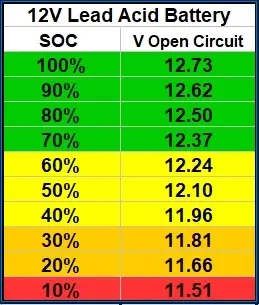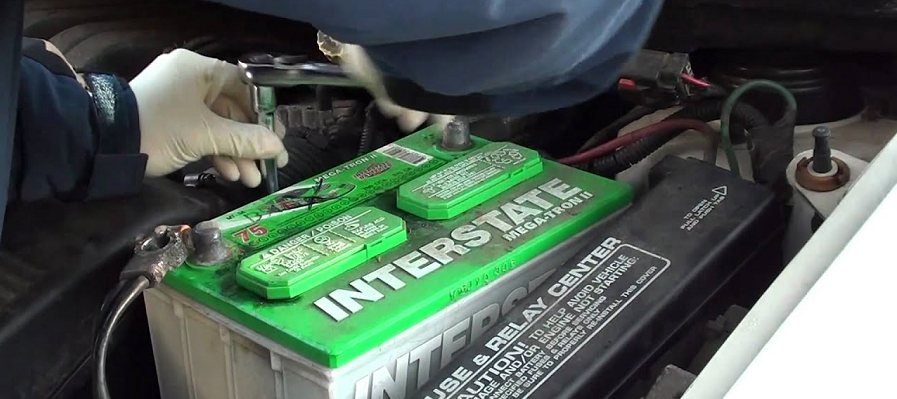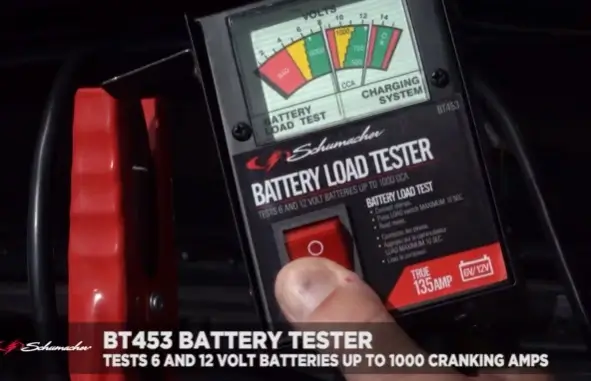How many volts does a 12-volt battery need to start a car? This is the most common question among car owners. Find out the answer and more tips here.
You have a 12-volt battery in your car, and you think it can start your car as long as it has 12 volts. But is that really true? How many volts does a 12-volt battery need to start a car? The answer is more than 12 volts. A 12-volt battery is an average voltage. It can change depending on how full, how old, and how hot your battery is.
To start a car, a 12-volt battery usually needs at least 12.4 volts, but sometimes more. But why is that? And what factors affect the voltage of your battery? This post will show you the difference between 12-volt and 12.4-volt batteries. I will also discuss the problems of having a low-voltage battery. I’ll also share the best ways to charge your battery properly.
Now, let’s jump right in!

Table of Contents
Key Takeaways
- A 12-volt car battery needs more than its labeled voltage to start a car, typically between 10-16 volts.
- The required voltage can vary. It depends on factors such as temperature and the battery’s condition.
- Understanding the necessary voltage can help prevent unexpected car breakdowns. It can also improve battery maintenance.
How Many Volts Does a 12-Volt Battery Need to Start a Car?
It sounds like a ridiculous question, but it really isn’t.
A car battery may need more volts to start than you would think. Let me explain.
A 12-volt car battery has six cells in it. Each cell provides 2.1 volts. So, a fully charged new car battery comes out of the factory with about 12.6 volts.
Let’s see how many volts are needed to start a car. Your car needs between 10 to 16 volts to start the engine. This depends on factors like the temperature.
A 12.6-volt battery is enough to start most cars. But when the voltage drops below 12 volts, things can get tricky. The colder it is, the more voltage you need. So, for your battery to perform well in freezing temperatures, it really needs to be on top form.
Maintaining your battery is crucial. A well-maintained battery can provide 13.7 to 14.7 volts while in use. This makes it easier for your engine to start.

Is 14.7 Volts OK for a Car Battery?
We’ve tried 12 volts, so let’s go a bit higher.
What Does a Voltage of 14.7 Volts Indicate?
By now, you already know that a 12-volt car battery usually needs a voltage within a specific range to work well. The voltage of a car battery while the engine is running should be between 13.7 and 14.7 volts. So, if you see a 14.7-volt reading, it’s perfectly okay!
The recommended car battery voltage should be around 12.6 volts when the engine is off. But this can vary depending upon the state of charge of the battery. However, this voltage can drop to 12.4 volts at 75% charge and even lower to 12 volts when the battery is down to a 25% charge.
So, how does the alternator fit the puzzle? It plays a big role in the battery’s voltage status. It maintains the proper voltage by recharging the battery while the engine runs. When an alternator works, the car battery voltage stays in the ideal range.
Is 12.5 Volts Enough to Start a Car?
Let’s find some middle ground.
What Does a Voltage of 12.5 Volts Indicate?
A voltage of 12.5 volts in a car battery indicates that it is not fully charged but still has some charge. A charged battery voltage ranges between 12.6 and 12.8 volts, while a battery with 75% charge can drop to around 12.4 volts. Depending on certain factors, a voltage of 12.5 volts may be enough to start the engine.
When you try to start your car, it needs a minimum voltage to power up the starter motor. If your battery has enough power, your engine will start, and you can be on your way.
Keep in mind that the voltage required to start a car varies between 12-14 volts. So, a battery reading 12.5 volts will often have enough voltage to start the engine for most vehicles. Colder temperatures and other factors can affect the power your car needs to start, so in some cases, 12.5 volts might not be sufficient.
I regularly check my car battery’s voltage level to make sure it stays within the ideal range.
Is 11.7 Volts OK for a Car Battery?
Now I’ve covered some of the meanings of the higher voltages, I think we need to look at those lower down the scale.
What Does a Voltage of 11.7 Volts Indicate?
Well, if the voltage of a car battery is 11.7 volts, you should be concerned. Because here’s the thing: When the engine is off, the voltage of a fully charged 12-volt battery should be around 12.6 volts. But a voltage as low as 11.7 volts indicates a dead battery.
There are a lot of reasons for low battery voltage. It could be due to a parasitic drain – a device that uses the battery’s power when the engine is off. It’s not rare for the car to lose some voltage overnight. All batteries start to lose power as soon as charging ceases. But a drop from 12.6 volts to 11.7 volts is huge and will leave you stranded.
Additionally, the battery could be old. As batteries age, their ability to hold a charge decreases. Like us, they have a natural lifespan and get weaker and fade out when they age. If your battery is around four years old, you might need to cut your losses and invest in a new battery.
But before you make a decision, you need to test the battery. You can use a multimeter or visit a mechanic once you have charged up. They will measure the voltage and give you a definitive diagnosis – and let you know whether you should stick or twist.
As well as your local grease monkey, most auto parts stores will test your battery completely free of charge.
How to Test Voltage
So, how do you test your battery’s voltage? Don’t worry; it’s a simple procedure anyone can do.
I use a multimeter to measure my car battery voltage easily. Let me guide you on how to perform this test.
First, grab a multimeter and set it to the DCV setting. You’ll want to choose the 20-volt option, as you are expecting around 12 volts from your car battery. Now, turn off your car’s engine and make sure all electronic devices are off, too.
With your multimeter ready, it’s time to check the voltage. Touch the red probe of the multimeter to the positive (red) terminal of your battery. Then, touch the black probe to the negative (black) terminal. Observe the reading on your multimeter’s screen.
So, how many volts does your battery have?
As we’ve seen earlier, a fully charged car battery should read around 12.6 volts. When the engine is running, it should range from 13.7 to 14.7 volts. If your battery is below 12.2 volts, you’re in trouble and need to think about a possible battery replacement.
Load Testing the Battery
But will the voltage check give you all the information you need? Well, not necessarily. For more information, we can perform a load test.
But why? We have already tested the voltage with the multimeter, right?
Well, sort of, but we may not have the whole picture.
Imagine you’re a detective, and your car battery is the mysterious character you’re trying to understand. You have two tools at your disposal: a multimeter (your trusty notebook) and a load tester (your magnifying glass).
The multimeter is like jotting down basic observations. It tells you the battery’s voltage, like noting someone’s appearance. But appearances can be deceiving, right? A battery might show the correct voltage but could still be weak, much like a suspect who seems innocent but has a secret.
Enter the load tester, your magnifying glass! It lets you see under the surface. When you perform a load test, you’re putting the battery under pressure, simulating the conditions it would face during a high-speed car chase or a late-night stakeout.
It’s like observing your suspect’s behavior under stress. If the battery maintains its voltage, it’s robust and reliable. But if the voltage drops, the battery might be hiding something – it could be nearing the end of its life.
So, while a voltage test gives you a snapshot, a load test reveals the full story, showing you how the battery performs when it truly matters. It’s the difference between a hunch and a solid lead. And in the world of car maintenance, that can be the key to keeping your vehicle on the road and ready for action!
Let’s dive into the world of car batteries and load testing!

What is a Load Test?
A load test assesses a car battery’s health by simulating its performance when the engine is running during normal vehicle operation. It’s like a stress test for your battery, pushing it to its limits to see how well it performs.
How to Perform a Load Test?
- Safety First: Always wear protective gloves and goggles. Batteries contain acid that can be harmful.
- Prepare the Battery: Turn off the vehicle and remove any corrosion from the battery terminals.
- Connect the Load Tester: Attach the load tester’s positive lead to the battery’s positive terminal and the negative lead to the negative terminal.
- Perform the Test: Activate the load tester. It will apply a load to the battery for around 15 seconds.
- Read the Results: After the test, the load tester will display the battery’s voltage under load. A healthy 12-volt battery should maintain a voltage above 9.6 volts during the test.
What Does It Tell Us? Well, I’m glad you asked! The load test tells us whether the battery can deliver enough current to power a car’s electrical systems under high demand. If the voltage drops below 9.6 volts, it’s a sign the battery may be unable to meet the vehicle’s power needs and could be nearing the end of its life.
Remember, regular load testing is a small step that can lead to a smoother and more reliable driving experience.
Before You Go…
You have a 12-volt battery in your car and know how to charge it with a 12-volt charger. But what about a 6-volt battery? Do you have any of them in your gadgets, your tools, or your toys? And if you do, how do you charge them? Can you charge a 6-volt battery with a 12-volt charger?
The answer is: yes, you can. But you probably shouldn’t. Charging a 6-volt battery with a 12-volt charger is inefficient and risky. It can reduce your battery’s lifespan, lower its capacity, and even cause a fire. But why is that? And what are the best options for charging a 6-volt battery?
In my next article, “Can You Charge a 6 Volt Battery with a 12 Volt Charger?” I will show you the difference between 6-volt and 12-volt batteries. I will also explain the problems of using the wrong charger. I will also explain the best ways to charge your 6-volt battery safely. I have tried this myself, and I have seen the results.
Frequently Asked Questions
Here’s the FAQs
How many volts does a car battery need to start?
A car typically needs at least 12 volts to start. When you turn the key, the electrical current flows from the battery to the starter motor. The motor then turns over the engine.
Is 10 volts enough to start a car?
No, 10 volts is not enough to start a car. The minimum voltage required is around 12 volts. If your battery is reading 10 volts, it’s likely weak or depleted. It needs charging or replacement.
Is 11.5 volts enough to start a car?
11.5 volts might be insufficient for starting a car. Generally, a healthy battery should be between 12.4 and 12.6 volts when the engine is off. If your battery reads 11.5 volts, it’s best to charge it before attempting to start your vehicle.
At what voltage is a car battery dead?
A car battery is considered dead when its voltage drops below 12 volts. Anything lower than this means the battery cannot start your vehicle.
What should a 12-volt battery read when fully charged?
A 12-volt battery should read between 12.6 and 12.8 volts when fully charged. It ensures the battery has enough power to start your car and run its electrical components.
Will a battery at 12.2 volts start a car?
A battery at 12.2 volts might struggle to start a car. Ideally, it should be between 12.4 and 12.6 volts when the engine is off. So, if your battery is reading 12.2 volts, it’s advisable to charge it before attempting to start the vehicle.
Related Articles
- How Long Does it Take to Charge a Car Battery with a 10 Amp Charger? The Ultimate Guide
- How Do You Stop a Car Battery from Draining When Not in Use? How to Spot and Fix Signs of Battery Drain
- Can You Charge a 48-volt Battery with a 12-volt Charger? The Surprising Reason Why This is a Bad Idea
- Can You Charge a 24-volt Battery with a 12-volt Charger? The Hidden Dangers you NEED to know


